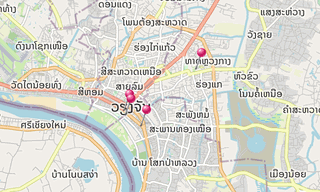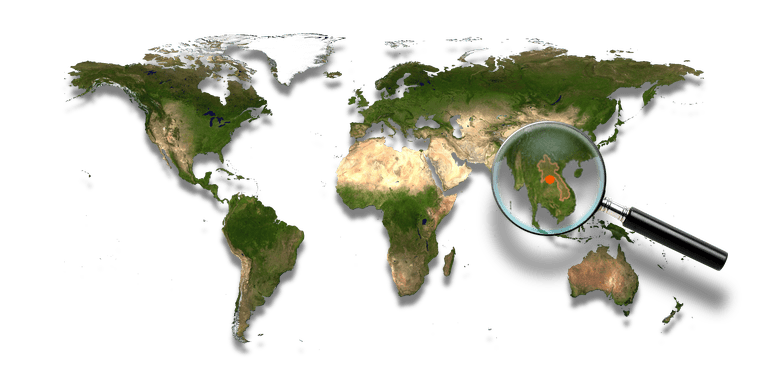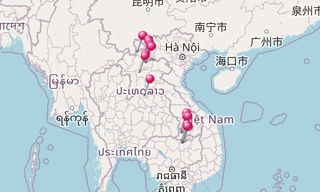Vientiane is the capital and largest city of Laos, on the banks of the Mekong River near the border with Thailand. Vientiane became the capital in 1573, due to fears of a Burmese invasion, but was later looted, then razed to the ground in 1827 by the Siamese (Thai).
Vientiane was the administrative capital during French rule and, due to economic growth in recent times, is now the economic center of Laos. The city had a population of 948,477 as of the 2020 Census. Vientiane is noted as the home of the most significant national monuments in Laos – Pha That Luang – which is a known symbol of Laos and an icon of Buddhism in Laos.
Other significant Buddhist temples in Laos can be found there as well, such as Haw Phra Kaew, which formerly housed the Emerald Buddha.
Haw Phra Kaew
Haw Phra Kaew (Ho Prakeo, Hor Pha Keo or Haw Pha Keo) is a religious building in Vientiane. It is a former royal temple transformed into a museum of religious art. This temple was probably built in the 16th century during the reign of Setthathirat to house the famous Emerald Buddha, which this king had brought back from northern Siam. But following a conflict with Thailand in 1779, the Siamese destroyed the temple and recovered the Emerald Buddha for deposit at Wat Phra Kaeo in Bangkok.
The current temple was rebuilt in 1936, according to original plans. Today the temple has been transformed into a museum. It contains a superb collection of bronze Buddhas and sacred works of art. A number of Buddhas are placed on the terrace, including stone Buddhas dating from the 6th to 9th century, and bronze standing and seated Buddha of later periods. More Buddhas images are displayed in the sim - the sim is the main ordination hall where the religious ceremony is conducted.
Pha That Luang
Pha That Luang (That Luang, meaning “great stupa”) is a Buddhist monument located in Vientiane. The most sacred monument in the country, it is believed to contain a Buddha hair. When King Sai Setthathirath I moved his capital from Luang Prabang to Vientiane, he is said to have commissioned the construction of a stupa on the ruins of a Khmer temple from the 13th century. The stupa was inaugurated by the king in 1566 under the name “Loka-Chulamani”. A temple was then built in each of the four cardinal directions.
The first level is 67 m by 68 m; the second is 47 m along each side; and the third level is 29 m along each side. From ground to pinnacle, the Pha That Luang is 44 m high.
Wat Si Muang
Wat Si Muang (Wat Simuong) is the most revered of the Buddhist shrines in Vientiane, with the exception of Pha That Luang. Today located in the city center, it marks the location of the south-eastern gate of the city. The temple was built in 1563, in the former Kingdom of Lan Xang.
A statue of King Sisavang Vong stands in front of Wat Si Muang. Inside, the temple is unusual in being divided into two rooms. The front room is quiet, with a monk usually on hand to give blessings. The rear room houses the large main altar, with statues and images of the Buddha.
Wat Si Saket
Wat Si Saket is the oldest temple in Vientiane. It was built in 1818 by order of King Anouvong. Each year, the king received the oath of loyalty from the officials there. It is the only construction in Vientiane to have been spared by the Siamese when the city was sacked in 1827, probably due to the typical Thai style from which its builders were inspired. Indeed, the single-nave sanctuary rises in the center of a courtyard surrounded by a gallery, an arrangement inspired by Thai architecture.
The pagoda has a superb coffered ceiling and walls decorated with polychrome frescoes depicting scenes from the life of the Master. The large seated Buddha is protected by a genius of the Earth, as are the two standing bronze Buddhas, personifying the king. The sanctuary is surrounded by a cloister pierced with four gabled doors. This houses many statues of Laotian-style Buddhas (terracotta, bronze, wood), dating from the 15th century to the 19th century.

.hero.landscape.jpg?w=1600)


.jpg?w=256)
.jpg?w=256)
.jpg?w=256)
.jpg?w=256)
.jpg?w=256)
.jpg?w=256)
.jpg?w=256)
.jpg?w=256)
.jpg?w=256)
.jpg?w=256)
.jpg?w=256)
.jpg?w=256)
.jpg?w=256)
.jpg?w=256)
.jpg?w=256)
.jpg?w=256)
.jpg?w=256)
.jpg?w=256)
.jpg?w=256)
.jpg?w=256)
.jpg?w=256)
.jpg?w=256)
.jpg?w=256)
.jpg?w=256)
.jpg?w=256)
.jpg?w=256)
.jpg?w=256)
.jpg?w=256)
.jpg?w=256)
.jpg?w=256)
.jpg?w=256)
-Market.jpg?w=256)
.jpg?w=256)
.jpg?w=256)
.jpg?w=256)
.jpg?w=256)
.jpg?w=256)
.jpg?w=256)
.jpg?w=256)
-Market.jpg?w=256)
.jpg?w=256)
.jpg?w=256)
.jpg?w=256)
.jpg?w=256)
.jpg?w=256)
.jpg?w=256)
.jpg?w=256)
.jpg?w=256)
.jpg?w=256)
.jpg?w=256)
.jpg?w=256)
.jpg?w=256)
.hero.jpg?w=320)
